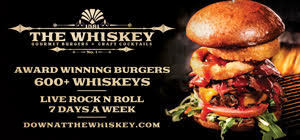A while ago I told you about the upscale seafood chain McCormick & Schmick’s, where the menu lists the origins of the featured fresh catches – blue marlin from San Jose, Costa Rica, for example.
This week we’re at another upscale seafood restaurant, Moonfish, where the menu gets even more specific. I not only know that my Black Island swordfish came from just off the coast of Cape Hatteras, I even know that it was caught – harpooned, to be exact – by Paul Josephs.
It may be more information than you need or want (heck, some people don’t even care what their waiter’s name is), but the bottom line, not to mention the hook and the sinker, is that the quality of seafood restaurants around here is getting better.
Moonfish is the latest concept from the Charley’s Steak House folks, Talk of the Town, Inc. They’re certainly not new to the seafood game. Just down Sand Lake Road you’ll find their other seafood restaurant, Fish Bones (not to be confused with Outback Steak House’s nearby Bonefish, and that you might perhaps find it confusing is the basis of a complaint against Outback by Talk of the Town calling for them to stop using that name, but that’s another story).
That swordfish, so ably harpooned by Josephs, was nicely grilled and had a smoky flavor to complement the firm texture and moist flakiness of the fillet.
More impressive was the Vietnamese basa, a catfishlike fish, fried whole and posed on the plate to make it look as though it might swim away. It had sweet flesh that was enhanced by slivers of whole ginger that had been placed in slits along the body. It was topped with a slaw tinged with toasted sesame oil that gave it an Asian edge.
The Alaskan halibut stuffed with blue crab, shrimp and brie just didn’t work. There wasn’t anything wrong with the fish itself; it had fresh qualities and good flavor. But that flavor was done no favor by the overpowering cheese.
It shouldn’t be surprising that steaks are properly prepared for those in the group that don’t care for fish. One of my guests had the 20-ounce bone-in New York strip ($18.95), grilled so the outside was crispy but the inside was pink and juicy, even with a requested temperature of medium-well.
For appetizers there was nothing better than the crab cake, which wasn’t very cakelike but rather a mound of lovely lump crab meat, slightly warm and rich in natural flavors.
For dessert there was an impressive sampler of sorbets, including pineapple, coconut, lemon and an unusual apple, all served in hollowed fruit. And the chocolate cake, an enormous slice of multi layers, moist and rich, the icing studded with chocolate chips, was also delightful.
Service tended toward the “let’s be friends” end of the spectrum. If you know the name of the person who caught your fish you’re certainly going to hear the name of the person serving it to you. The wine list has a number of good selections but precious few by the glass.
The moonfish, also known as opah, figures into the decor beginning with a manhole-sized door handle on the entrance. Round shapes, not necessarily fish in form, have been worked into the interior, which also features a slate entry way, dark woods and the signature wood-fired pit at the front of the kitchen.
Tables are covered with white cloths then topped with butcher paper. (Note to staff: check the stains on the portion of the cloth that hangs down, please, and change them when necessary.) The dining room is inexplicably noisy – there aren’t a lot of hard surfaces, but in a room that was only a little more than half full, my guests and I had trouble hearing each other across the table.
Still, the surroundings are mostly pleasant, and the quality of the seafood is encouraging.









